Ten thousand mighty tamaraw buffalo (Bubalus mindorensis) once grazed the mountain slopes of Mindoro Island in the Philippines. However, these dwarf buffalo are now classified as Critically Endangered on the IUCN Red List, with fewer than 300 individuals remaining on the small island to which they are wholly endemic. Yet hope remains for the tamaraw: an enormous effort has been mounted to revive this iconic species and to protect its unique island habitat.
The World Wide Fund for Nature Philippines (WWF-Philippines) has joined top academic institution Far Eastern University (FEU), alongside well-established environmental groups in Mindoro, with the goal of doubling the wild tamaraw population from 300 to 600 by 2020.
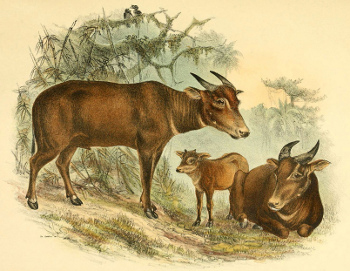 Illustration of the tamaraw. For photos of the tamaraw: Arkive: tamaraw. |
Considered a national symbol in the Philippines, the tamaraw is the largest native terrestrial mammal to Mindoro. That said, it is relatively small when compared to other buffalo species and is considered a dwarf buffalo, standing only a meter tall (3.2 feet) and weighing between 200-300 kilograms (440-660 pounds) when fully grown. The tamaraw is dark brown with light markings on the belly. These markings are also found over its eyes, creating the effect of eyebrows. They have short, thick horns, which form a distinctive V-shape. Tamaraw are nocturnal in nature, though it is speculated that this is likely the result of adaptation to human disturbance. Decades of trophy hunting, land clearing for agriculture and an outbreak of the viral disease Rinderpest in the 1930s have had a devastating impact on the tamaraw population.
“Ultimately, our engagement will revitalize key mountain habitats in Occidental Mindoro, with the tamaraw as its conservation icon,” said WWF-Philippines Vice-Chair and CEO Jose Ma. Lorenzo Tan in a press release. “Healthy peaks and forests translate to a better-managed source of water so essential for the vast rice lands of this island’s western floodplains, while healthy reefs generate vast amounts of protein. Our goal is two-fold—to double the number of wild tamaraw by 2020—and to ensure that the ridges and reefs of Mindoro remain productive to adequately provide for its people in a climate-defined future.”
The island of Mindoro is one of seven distinct bio-geographical zones in the Philippines and supports the productive ecosystems of the Iglit-Baco mountain range and Apo Reef. The comprehensive tamaraw conservation effort brings together long-standing tamaraw research; ongoing efforts to protect the Apo Reef and other marine riches; and improved oversight and regulations for parks and public land use.
View Larger Map
Related articles
Endangered fruit bats, and many other species, on the menu in the Philippines
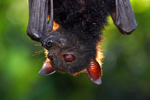
(07/09/2012) Bushmeat hunting is well-known to be decimating animal populations in Africa, but has been little studied much of Southeast Asia. However, a new paper in mongabay.com’s open access journal Tropical Conservation Science shines light on the size and scale of bushmeat poaching in the Philippines. Studying an anonymous community near a national park on the island of Luzon, researchers found that poachers targeted 22 species, ten of which are considered either threatened or near threatened with extinction by the IUCN Red List.
Eye-popping purple crabs discovered in the Philippines
(04/23/2012) Scientists have discovered four new species of brilliantly-colored freshwater crabs on the Philippine island of Palawan. Described in the Raffles Bulletin of Zoology, the new species expands the genus, Insulamon, from one known crab species to five. Although its ecosystems are threatened by widespread mining and deforestation, the Philippines is a mega-diverse country, meaning that it belongs to a select group of 17 countries that contain the bulk of the world’s species.
Two new frogs discovered in Philippines spur calls for more conservation efforts
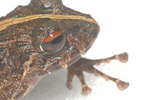
(04/19/2012) Two new frogs have been discovered on the Philippine island of Leyte during a biological survey last year by Fauna and Flora International, which also recorded a wealth of other species. Discovered in November on the island’s Nacolod mountain range, the frogs have yet to be named. The Philippines is one of the world’s global biodiversity hotspots, yet suffers from widespread deforestation and degradation.
Two-foot-long cloud rat rediscovered after missing for forty years in the Philippines
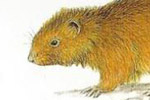
(04/17/2012) Czech computer programmer, Vaclav Rehak, was the first person to see a living Dinagat bushy-tailed cloud rat (Crateromys australis) in nearly forty years, reports GMA News. Rehak was traveling on Dinagat Island with his new wife, Milada Rehakova-Petru, a specialist on Philippine tarsiers, when he stumbled on the rodent, which has only been recorded once by scientists in 1975. Found only on the Dinagat Island, the rodent was feared extinct, but is now imperiled by mining concessions across its small habitat, which is thought to be less than 100 square kilometers.
Tiny tarsier makes big, ultrasonic noise
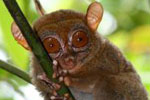
(02/13/2012) The Philippine tarsier (Tarsius syrichta), a 5-inch tall Southeast Asian primate, has long resembled a ventriloquist’s doll. It would open its mouth as though chattering away, but researchers heard nothing. Now, a new study in Biology Letters has found out why: the Philippine tarsier communicates ultrasonically, surpassing all other primates, and nearly all terrestrial mammals, in its ability to create sounds in the upper registry.
Philippines disaster may have been worsened by climate change, deforestation

(12/20/2011) As the Philippines begins to bury more than a 1,000 disaster victims in mass graves, Philippine President Benigno Aquino has ordered an investigation into last weekend’s flash flood and landslide, including looking at the role of illegal logging. Officials have pointed to both climate change and vast deforestation as likely exacerbating the disaster.
Giant snakes commonly attacked modern hunter-gatherers in Philippines

(12/13/2011) Humans have an ambivalent relationship with snakes. The legless reptiles are often feared and reviled, becoming stand-ins for the Devil and movie monster characters; yet many people have grown to love snakes, raising large, even dangerous, specimens as pets. Now, new research suggests that the ecological role between snakes and humans, as well as other primates, is more nuanced than expected. After spending decades living among the Agta Negritos people in the Philippines, anthropologist Thomas Headland has found that the hunter gatherer tribes were quite commonly attacked by reticulated pythons (Python reticulatus), while the people themselves had no qualms with hunting, killing, and consuming python.